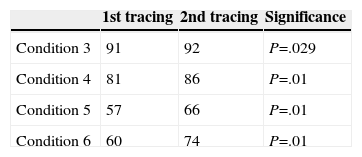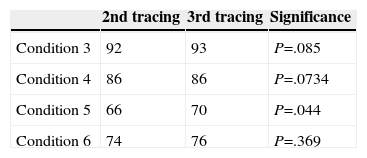The sensory organisation test (SOT) is the gold-standard test for the study of postural control with posturographic platforms. Three registers of Conditions 3, 4, 5 and 6 are conducted to find an arithmetic mean of the 3, with the time that this entails. The aim of this study was to determine whether a single record for each SOT condition would give us the same information as the arithmetic mean of the 3 recordings used until now.
Materials and methods100 healthy individuals who performed a sensory organisation test in the Smart Balance Master® Neurocom platform. For the statistical analysis we used the Wilcoxon test for nonparametric variables and dependent t-student for paired samples for parametric variables (P<.05).
ResultsWhen comparing the scores on the first record with the average of the 3 records, we found statistically significant differences for the 4 conditions (P<.05). Comparing the first record to the second record also yielded statistically significant differences in the 4 conditions (P<.05). Upon comparing the second record with the third, however, we found differences in only Condition 5, with the significance being borderline (P=.04). Finally, comparing the average of the first and second record with the average of the 3 records, we also found statistically significant differences for the 4 conditions (P<.05).
ConclusionUsing only 1 or 2 records from each of the conditions on the SOT does not give us the same information as the arithmetic average of the 3 records used until now.
El test de organización sensorial (SOT) es el gold estándar del estudio del control postural con plataformas posturográficas. En dicha prueba se realizan 3 registros, al menos, de la condiciones 3, 4, 5 y 6, para hallar una media aritmética de las 3, con el tiempo que esto conlleva. El objetivo de este trabajo es determinar si un único registro de cada condición del SOT nos aporta la misma información que la media aritmética de los 3 registros realizados hasta el momento.
MétodosCien individuos sanos a los que se le realizó un registro posturográficos en la plataforma Smart Balance Master de Neurocom®. Estudio estadístico: test de Wilcoxon para variables no paramétricas y t-student para muestras relacionadas para variables paramétricas (p<0,05).
ResultadosAl comparar las puntuaciones obtenidas en el primer registro con la media de los 3 registros encontramos diferencias estadísticamente significativas para las 4 condiciones (p<0,05). Si comparamos el primer registro con el segundo también encontramos diferencias estadísticamente significativas en las 4 condiciones (p<0,05). Al comparar el segundo registro con el tercero, sin embargo, solo encontramos diferencias en la condición 5, estando la significación en el límite (p=0,04). Y comparando la media del primer y segundo registro, con la media de los 3 registros, también encontramos diferencias estadísticamente significativas para las 4 condiciones (p<0,05).
ConclusiónUn único registro, incluso 2, de cada una de las condiciones del SOT, no nos aporta la misma información que la media aritmética de los 3 registros realizados hasta el momento.









